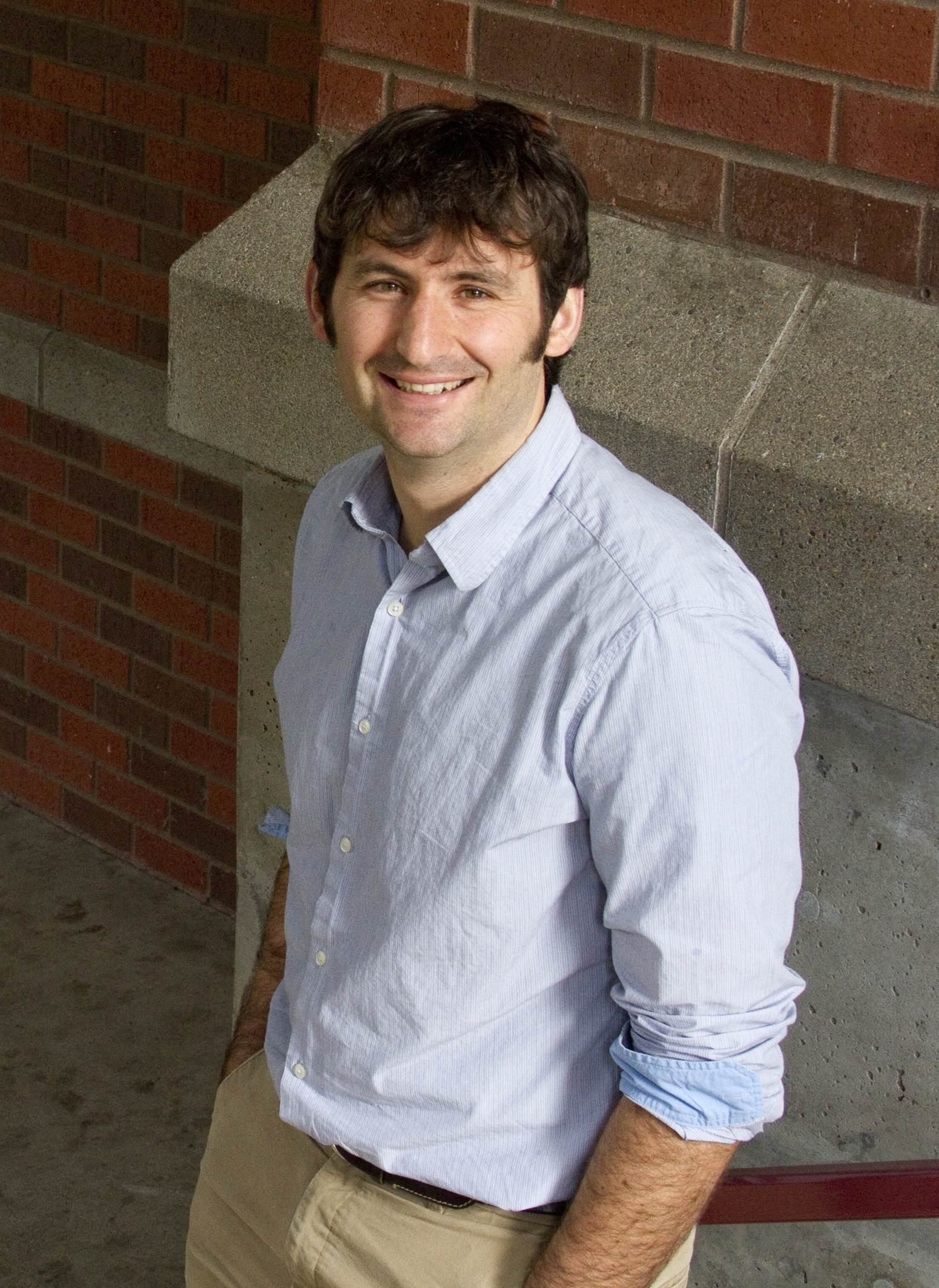

Faculty Recruiting Seminar
Wednesday, December 16, 3:30-4:30, ZOOM
Washington Research Foundation Postdoctoral Fellow
University of Washington
PhD, UC Berkeley, 2017 (Naomi Ginsberg)
Abstract: Many energy technologies, including solar cells and batteries, appear static on the macroscale, but dynamic processes at small length scales determine the efficiency of these technologies. For instance, structural transformations, such as solid-solid phase transitions, are ubiquitous in energy technologies. Although bulk measurements are used commonly to benchmark device performance, the underlying heterogeneous, dynamic chemical processes that determine performance are difficult to capture at relevant length and time scales. I will describe how I work as a “movie maker” of dynamic nanoscale processes in materials. Using cathodoluminescence nanoscale imaging with in situ heating, I will first present the mechanism of a structural phase transition in lead halide perovskite photovoltaic materials that is detrimental to solar cell performance. I will then show that certain organic conjugated polymers can undergo structural phase transitions upon electrochemically-driven ion insertion, behaving more like inorganic materials than traditional conjugated polymers. Together, these two studies demonstrate that understanding dynamic structure-function relationships is key to designing the next generation of energy technologies.
Publications (Google Scholar Citations)
ORCID: https://orcid.org/0000-0002-3071-4069
h-index: 14 Total Citations:1712 (Google Scholar Citations, Nov. 2020)
Faculty Recruiting Seminar
Monday, December 14, 3:30-4:30, ZOOM
Burroughs Wellcome CASI Postdoctoral Researcher
UC Berkeley
PhD, Berkeley/UCSF 2018 (Bioengineering)
Abstract: Biological molecules rarely act alone. For example, in many pediatric cancers, a chromosomal rearrangement results in a fusion protein with altered DNA and protein interactions that yield proliferative and aggressively metastatic cell subpopulations. In this talk I will describe quantification of molecular interaction properties relevant to fusion oncoprotein biology using microscale tools with distinct forces tailored to each biological question. First, I will discuss measurement of cellular heterogeneity in cytoskeletal protein complex abundance as is needed to uncover ‘rogue’ metastatic and drug resistant cells. I introduced a microfluidic biochemical assay using electrophoretic forces and sieving hydrogels to fractionate dynamic protein complexes from single cells faster than dissociation kinetics. Second, I will describe biophysically probing protein-DNA molecular mechanics to understand how tension plays a role in DNA pairing during DNA damage repair. To reveal forces the Rad51 repair protein exerts on DNA, microscale tweezers apply a magnetic piconewton-scale force to single molecules of DNA. Finally, I will share future directions discerning the biochemical and biophysical roles of multi-component protein complexes in fusion oncoprotein-driven pediatric cancers such as Ewing’s sarcoma. My group will uncover new targets for ‘molecularly surgical’ Ewing’s sarcoma therapies through interrogation of molecular interactions towards replacing combination chemotherapy and crude tumor removal surgeries.
Publications (Google Scholar Citations)
ORCID: https://orcid.org/0000-0001-5456-6366
h-index: 8 Total Citations: 319 (Google Scholar Citations, Nov. 2020)
Faculty Recruiting Seminar
Tuesday, December 8, 3:30-4:30, ZOOM
Assistant Professor
Miami University (Ohio)
PhD, Michigan 2016
We develop nanoscale electrochemical tools to answer fundamental problems in electrochemistry, with the goal of their application in energy and biomedicine. Specifically, we are interested in fundamental electrocatalytic processes for energy storage and conversion at the nanoscale to reveal their heterogeneity and stochasticity. We are also devoted to developing electrochemical sensors and on-demand drug release devices for biomedical applications.
Publications (Google Scholar Citations)
ORCID: https://orcid.org/0000-0002-9480-8881
h-index: 13 Total Citations: 456 (Google Scholar Citations, Nov. 2020)
Faculty Recruiting Seminar
Wednesday, December 2, 3:30-4:30, ZOOM
Postdoctoral Researcher
University of Pennsylvania
PhD, Columbia University 2016
Abstract: At the intersection of Chemistry and Physics lies many gaps that have been ignored when we learned about light-matter interactions, particularly between quantum chemistry and classical electrodynamics. Recent experiments in nanoplasmonics and quantum spectroscopy highlight the significance of bridging these gaps and require accurate and efficient treatments of strong light-matter interactions for molecules and materials. Such systems usually involve multiple timescales (nuclear motions versus optical frequencies), heterogeneous environments (cavities or nanoparticles), and emerging quantum effects (hybridization of electronic and photonic excitations), rendering traditional approaches difficult to capture many exciting phenomena and fundamental effects. In this talk, I will introduce novel semiclassical models to capture quantum features of molecular fluorescence and incorporate the dynamical interplay of nuclear motion and photoexcitation. The results highlight the fact that, when properly designed, a combination of quantum dynamics and classical electromagnetism can provide accurate, affordable approaches for modeling strong light-matter coupling phenomena and lead to applications in energy-efficient materials and quantum computation.
Publications (Google Scholar Citations)
ORCID: https://orcid.org/0000-0002-6619-1861
h-index: 8 Total Articles: 18 Total Citations: 186 (Web of Science, Nov. 2020)
h-index: 9 Total Citations: 241 (Google Scholar Citations, Nov. 2020)
Faculty Recruiting Seminar
Monday, November 23, 3:30-4:30, ZOOM
Postdoctoral Fellow
Johns Hopkins School of Medicine
Department of Biophysics and Biophysical Chemistry
PhD, Emory University 2016
Abstract: "Perturb and observe" is a powerful strategy to understand the natural world. My research to date focused on engineering molecules that enable manipulating/visualizing specific biological processes at high resolution, ultimately helping unravel their underlying mechanisms in a quantitative and time-resolved manner. I will first discuss my graduate research, where I built a series of FRET-based molecular tension sensors (MTS) that respond to single receptor forces at the piconewton scale. Conventional force measurement techniques (e.g., AFM, Optical tweezer) have either limited throughput or low sensitivity to quantify forces at the molecular level. Through MTSs, I generated the first fluorescence microscopy maps of single integrin and T-cell receptor forces in living cells, demonstrating that the intricate mechano-chemical coupling at the cell surface is vital in regulating biological functions such as cell adhesion, migration, and T-cell activation. Next, I will introduce my postdoctoral work, where I developed a very fast CRISPR (vfCRISPR) endonuclease system to investigate chromosome dynamics and genome maintenance. vfCRISPR consists of photochemically caged nucleotides in guide RNAs and represents the only molecular tool that can optically trigger genomic double-strand breaks with second-scale temporal resolution and subcellular spatial resolution. Compared to other methods that induce genomic damages (e.g., ionizing radiation, chemical reagents), vfCRISPR enables investigation into the spatiotemporal dynamics of DNA repair from an infinite pool of endogenous DNA targets with sequence specificity. vfCRISPR and its chemical upgrades described in the research plan have enormous potential to improve precision genome editing and transform DNA repair studies by offering unprecedented controllability in space and time.
Publications (Google Scholar Citations)
ORCID: https://orcid.org/0000-0002-3889-9707
h-index: 9 Total Articles: 11 Total Citations: 457 (Web of Science, Nov. 2020)
h-index: 13 Total Citations: 846 (Google Scholar Citations, Nov. 2020)
Thursday, October 8, 3:30 - 4:30pm, ZOOM
Associate Professor
University of Minnesota
Our general approach involves working at the intersection of materials science, physical chemistry, and condensed-matter physics to develop new ways of studying lattice and molecular, electronic, and magnetic dynamics spanning a broad range of space and time. In this way, we aim to develop a rich, comprehensive picture of energy processes - from the level of atoms and charge carriers up to classically-described nanomechanics. Central to our methods is the development and application of novel time-resolved techniques, such as ultrafast electron microscopy, in order to gain access to largely unexplored parameter space.
Publications (Google Scholar Citations)
h-index: 21 Total Articles: 49 Total Citations: 2117 (Web of Science, Sep. 2020)
h-index: 26 Total Citations: 3199 (Google Scholar Citations, Sep. 2020)
A&P + Inorganic Seminar
Thursday, September 24, 3:30 - 4:30pm, ZOOM
Associate Professor
University of North Carolina Chapel Hill
Abstract: The conversion of energy-poor feedstocks like water and carbon dioxide into energy-rich fuels involves multi-electron, multi-proton transformations. In order to develop catalysts that can mediate fuel production with optimum energy efficiency, this complex proton-electron reactivity must be carefully considered. Using a combination of electrochemical methods and time-resolved spectroscopy, we have revealed new details of how molecular catalysts mediate the reduction of protons to dihydrogen and the experimental parameters that dictate catalyst kinetics and mechanism. Through these studies, we are revealing opportunities to promote, control and modulate the proton-coupled electron transfer reaction pathways of catalysts.
h-index: 28 Total Articles: 57 Total Citations: 3143 (Web of Science, Sep. 2020)
Thursday, August 20, 3:30 - 4:30pm, ZOOM
Associate Professor
Ohio State University
Recent innovation in mass spectrometry (MS) is the ability to generate intact molecular ions, focus and use them as ordinary reagents for organic reactions at ambient surface, outside the mass spectrometer. Most projects in the Badu lab build on this innovation, but instead of simple organic compounds, we focus on drugs and biomolecules of specific biological importance. For example, selected proteins and antibodies can be aerosolized, and the resulting molecular cations/anions are directed onto a surface (paper, glass, tissue sections, etc.) for specific molecular recognition. Such experiments are expected to allow rapid and sensitive detection of drugs, tumor markers and antigens of infectious diseases. We are designing novel molecular probes for ambient MS analysis and imaging of proteins, antibodies, antigens, nucleic acids, and other disease biomarkers. The probes are rationally designed to facilitate (1) point-of-care and direct-to-customer applications with handheld mass spectrometers, and (2) a novel on-demand disease diagnostic concept that permits onsite friendly sample collection followed by analysis at a later time without affecting diagnostic outcome. Major efforts in our lab are also dedicated to the introduction of charged aerosols for treating respiratory diseases. This research has potential to advance our current understanding in aerosol therapy, and may yield new focus for general drug synthesis in which molecular ions, instead of their neutral counterparts, are used in medicine.
Publications (Google Scholar Citations)
ORCID: https://orcid.org/0000-0001-8642-3431
h-index: 19 Total Articles: 44 Total Citations: 1048 (Web of Science, Aug. 2020)
h-index: 21 Total Citations: 1405 (Google Scholar Citations, Aug. 2020)
Thursday, May 14, 3:30 - 4:30pm, ZOOM
Assistant Professor
Baylor University
Abstract: Glycans are complex molecules with different carbohydrate subunits, linkage stereochemistries, and branching patterns; all of which play a role in their biological functions. Hydrogen / deuterium exchange–mass spectrometry (HDX-MS) has become a standard method for analyzing conformations and binding interactions of solvated proteins. Carbohydrates, model systems for glycans, are susceptible to HDX since they contain labile hydrogens, primarily in the form of hydroxyls, which can be labeled with deuterium (D) upon exposure to deuterated solvents. However, compared to backbone amides, the functional group detected in traditional HDX-MS experiments for proteins, the exchange rate of glycan hydroxyls is two to eight orders of magnitude faster, depending on solution pH. This rapid exchange rate makes it unfeasible to monitor HDX of carbohydrate hydroxyls using traditional, bottom-up HDX methods. Herein, we describe our ongoing efforts to characterize solvated carbohydrates. We perform rapid HDX by introducing deuterating reagents (e.g. D2O) to carbohydrates during electrospray ionization (ESI). Our work illustrates that these rapid, in-ESI HDX methods characterize solvated carbohydrates rather than gas-phase structures. Furthermore, we have coupled our experimental work with molecular dynamics simulations to identify the mechanism of carbohydrate ionization during ESI. Experimentally, we have quantified how ESI source conditions alter the magnitude of HDX for carbohydrate model systems, developed an internal standard to control for daily humidity differences, and established methods to alter the HDX labeling time on the microsecond to millisecond timescale. We are now applying these in-ESI HDX methods to characterize carbohydrate isomers.
Publications (Google Scholar Citations)
ORCID: https://orcid.org/0000-0002-5411-7285
h-index: 6 Total Articles: 20 Total Citations: 99 (Web of Science, Apr. 2020)
h-index: 8 Total Citations: 149 (Google Scholar Citations, Apr. 2020)
Thursday, March 5, 3:30 - 4:30pm, WEL 2.122
Professor
University of Kansas
Abstract: How the properties of molecular systems change with temperature is one of the most fundamental issues in chemistry. Knowledge of this behavior has not only practical implications, but fundamental ones, as it permits the separation of energetic and entropic driving forces. In this talk, recent advances in the calculation and interpretation of the activation energy for a dynamical process will be discussed. Specifically, new approaches that enable the direct determination of the activation energy for any timescale from simulations at a single temperature will be presented. These methods open up significant new possibilities for understanding dynamics from diffusion to reorientation to chemical reaction in cases where a traditional Arrhenius analysis is not possible or applicable. They also enable otherwise unavailable mechanistic insight via a rigorous decomposition of the activation energy into contributions associated with the different interactions (e.g., Coulombic, Lennard-Jones) and motions present in the system. The approach is illustrated by application to the diffusive and reorientational dynamics of water under ambient and supercooled conditions.
Publications (Google Scholar Citations)
ORCID: https://orcid.org/0000-0002-3636-6448
h-index: 34 Total Articles: 127 Total Citations: 3503 (Web of Science, Feb. 2020)
h-index: 29 Total Citations: 2465 (Google Scholar Citations, Feb. 2020)
Monday, February 24, 3:30pm - 4:30pm, WEL 2.122
Associate Professor
University of Oregon
Abstract: Water is arguably the most-important molecule to humanity due to its ubiquitous role in biological, industrial, and environmental processes. Reactions of water typically involve breaking the H-O bond. The simplest reaction is heterolytic water dissociation (WD), H2O -> H+ + OH-, the understanding of which has been a focal point of experiment and theory for decades. Related dissociative adsorption reactions occur on surfaces and are important when water is used as a reactant for thermochemical processes, such as the water-gas-shift reaction. In biological systems, metalloenzymes such as carbonic anhydrase dissociate water to catalyze, for example, CO2 equilibria. WD is further a fundamental elementary step in many electrochemical processes. For example, the WD step is thought to be rate-limiting for the hydrogen evolution reaction (HER) under alkaline conditions and thus modification Pt HER catalysts with metal hydroxides, that presumably accelerate WD, lead to large increases in HER activity. While measurements of dissociative water adsorption are often made using the tools of surface science under vacuum conditions, the WD reaction has not been systematically studied under electrochemical conditions. We use a bipolar-membrane (BPM) electrolyzer (where WD is driven in the region between a hydroxide-exchange membrane and a proton-exchange membrane by an applied potential) to study WD kinetics across a range of materials. We find that the local pH is a critical, but previously unrecognized, variable affecting WD kinetics and a pH dependent proton transfer WD mechanism is proposed. Combining WD catalysts efficient in locally acidic conditions with those efficient in basic conditions, nearly eliminates the WD overpotential in BPM electrolyzers operating at 20 mA cm-2. The catalysts enable continuous BPM operation at 0.5 A cm-2 with a total applied electrolysis potential of ~ 2 V – substantial improvements over the state of the art and suggesting new applications for BPMs. We further discovered that the WD kinetics measured in the BPM correlate with HER kinetics under conditions where WD is an important elementary step. We discuss the design of bifunctional electrocatalysts based on the insight into the underlying WD steps.
Publications (Google Scholar Citations)
ORCID: https://orcid.org/0000-0001-8971-9123
h-index: 43 Total Articles: 109 Total Citations: 16,278 (Web of Science, Jan. 2020)
h-index: 45 Total Citations: 18,667 (Google Scholar Citations, Jan. 2020)
 Thursday, February 20, 3:30pm - 4:30pm, WEL 2.122
Thursday, February 20, 3:30pm - 4:30pm, WEL 2.122
Professor
University of Warwick
Warwick Electrochemistry & Interfaces
Abstract: With a focus on sp2 carbon materials – graphite, graphene and single walled carbon nanotubes (SWNTs) – and conducting diamond, this lecture will discuss recent advances in carbon electrochemistry and the process of challenging ‘conventional thinking’. Carbon materials have long been used as electrodes in electrochemistry, with applications from (bio)electroanalysis to energy technologies, such as batteries and fuel cells. With the advent of new forms of nano-carbon, carbon electrode materials have taken on even greater significance in electrochemistry. Textbook models for the response of carbon electrode materials have emphasized the importance of surface defects as active sites, even for simple redox processes. We have pioneered new electrochemical imaging techniques to test these models and examine the intrinsic electrochemical activity of carbon materials directly and with unprecedented detail and spatial resolution. When high resolution electrochemical imaging data are combined with information from other microscopy and spectroscopy techniques applied to the same area of an electrode surface, in a correlative-electrochemical microscopy approach, highly resolved and unambiguous pictures of electrode activity are revealed. These new views of the electrochemical properties of carbon materials are consistent over a wide range of length scales and time scales, and allow the rational design of next generation carbon electrode surfaces.
Publications (Google Scholar Citations)
h-index: 61 Total Articles: 357 Total Citations: 14,075 (Web of Science, Feb. 2020)
h-index: 71 Total Citations: 19,302 (Google Scholar Citations, Feb. 2020)
Thursday, February 13, 3:30pm - 4:30pm, WEL 2.122
Assistant Professor
University of Arizona
Abstract: Due to their important biochemical roles, membrane proteins are important drug targets. Although it is clear that lipids can influence membrane protein function, the chemistry of lipid binding remains difficult to study because protein-lipid interactions are polydisperse, competitive, and transient. Furthermore, detergents, which are often used to solubilize membrane proteins, may disrupt lipid interactions that occur in lipid bilayers. We have been developing new approaches to quantify protein-lipid interactions in bilayers and understand how membrane proteins remodel their surrounding lipid environment. In one new approach, we use mass spectrometry (MS) to quantify the exchange of lipids between lipoprotein nanodiscs with and without an embedded membrane protein. Shifts in the lipid distribution towards the membrane protein nanodiscs reveal lipid binding, and titrations allow measurement of the optimal lipid composition for the membrane protein. Second, we use native MS to ionize membrane protein nanodiscs with heterogeneous lipids. Ejecting the membrane protein complex with bound lipids in the mass spectrometer revealed enrichment of specific lipids around the membrane protein. Ultimately, we expect these unique combinations of nanodiscs and MS will provide new insights into the chemistry and selectivity of membrane protein-lipid interactions.
Publications (Google Scholar Citations)
ORCID: https://orcid.org/0000-0001-8115-1772
h-index: 16 Total Articles: 34 Total Citations: 809 (Web of Science, Jan. 2020)
h-index: 15 Total Citations: 835 (Google Scholar Citations, Jan. 2020)
The Seminars page is brought to you by the University Libraries. Our intent is to provide a quick profile of our guest speakers, links to their research group sites, recent publications, author metrics, and other information to enhance your engagement with the guests.

This work is licensed under a Creative Commons Attribution-NonCommercial 4.0 Generic License.